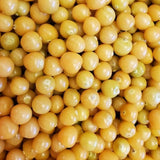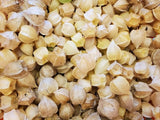New Hanover Ground Cherry
Physalis pruinosa
This round, yellow ground cherry in a papery husk is sweet with a backbeat of yellow tomato. According to William Woys Weaver, from whom we received our seeds, this heirloom variety was preserved by Katie Hoffman Slonaker (1903–1983) on her farm in New Hanover, Pennsylvania. Jo Rosen grew this variety at her farm in Massachusetts and preferred its flavor and productivity to the ever-popular Pineapple Ground Cherry.
Kids of all ages love finding tiny wrapped packages and eating the bite-sized fruits like candy right in the garden, or several weeks later in fruit salad or over ice cream, as they store well in their husks. Naturally high in pectin, they make great preserves and pies as well. This distant cousin of tomato and tomatillo falls to the ground when ripe, which gives this plant its name.
Days to maturity: 65-75
Seeds per pack: 150
Germination rate: 74% on 06/17/2025
Planting / harvesting notes
Sow indoors 1/4" deep around 6 weeks before the last frost date. Germination can take as long as 20 days, but can be sooner if set on a heat mat with a temperature between 75 and 80 degrees F. Transplant in the garden in rows about every 18"-24". Plants will form blousy bushes like tomatillos. Keep well weeded until they fill in the space in order to best find the fallen fruits later in the season; some growers put down weed barriers (plastic, cloth, or newspaper) under the plants to prevent those weeds and more easily see the fallen fruits. Harvest when the husks turn brown and the fruits are yellow. For winter use, store the fruits unhusked in a dry, airy place (like a basket). To eat, remove the husk and eat the yellow fruit raw or bake in pies or stew with sugar for jam.
Note: Unripe, green ground cherries and their leaves and husks are bitter and toxic. Do not eat!
Seed keeping notes
Ground cherries are self-pollinating, but different varieties of the P. pruinosa should be isolated by several hundred feet to prevent unwanted cross-pollination. Seeds are ready for harvest when fruit is ripe. A single fruit can have 100 seeds! You can remove seeds by hand, rinse, and dry. We use a blender on the lowest setting with plenty of water. When the fruits have been broken open, pour the mixture into a large container and add water. Allow the fruits to float and the seeds to sink. Pour off everything except the seed (you may have to add more water and repeat this process a few times) and then strain and rinse the seeds, and dry. However, you may never need to replant ground cherries after your first year - they tend to reseed themselves!







